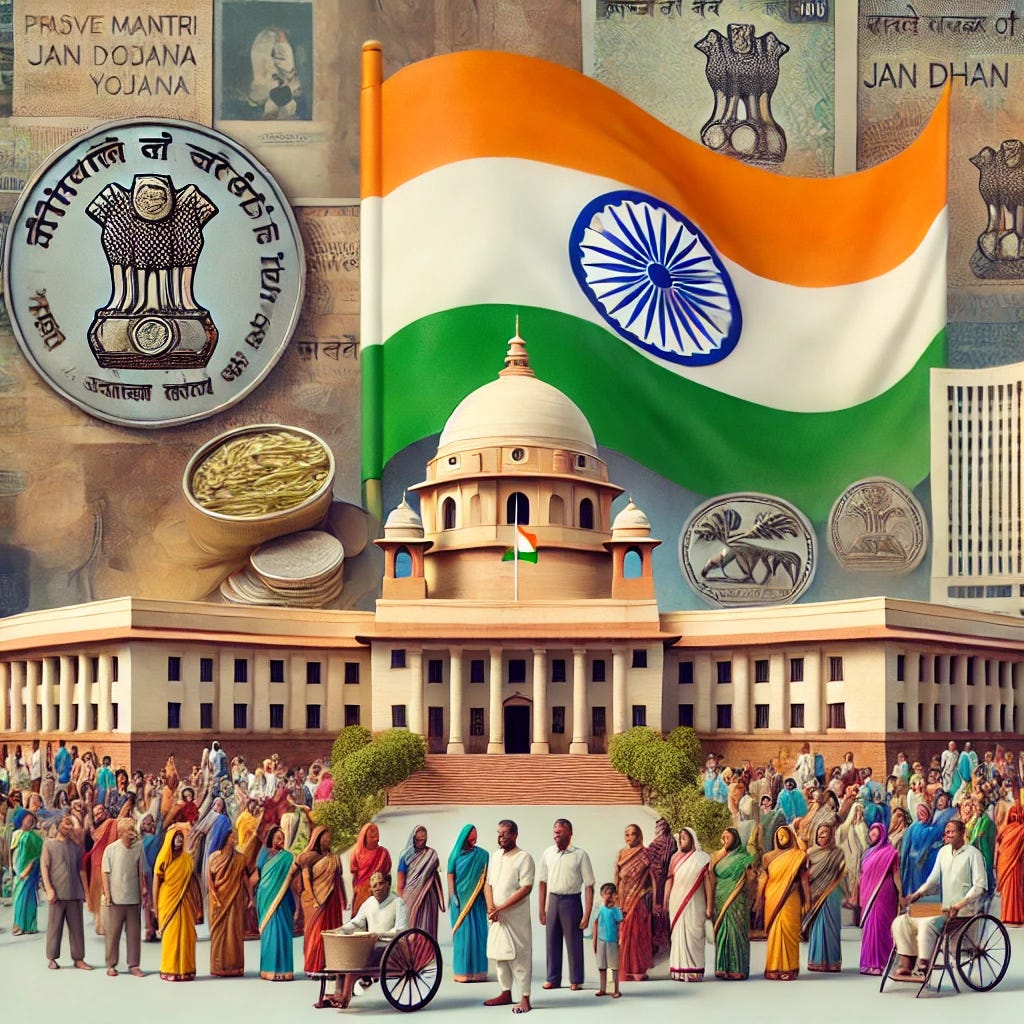Jan Dhan Yojana: A Decade of Financial Inclusion in India
More than just a tool for financial inclusion, PMJDY has also served as a powerful instrument of social empowerment for vulnerable sections of society. But arduous path ahead.
Pradhan Mantri Jan Dhan Yojana
The Pradhan Mantri Jan Dhan Yojana (PMJDY), India's flagship financial inclusion programme, has reached a significant milestone, completing ten years since its launch in 2014. This ambitious scheme has played a pivotal role in integrating millions of unbanked Indians into the formal financial system, thereby transforming the country's banking landscape. More than just a tool for financial inclusion, PMJDY has also served as a powerful instrument of social empowerment for vulnerable sections of society, including marginal farmers, landless labourers, tribals, and women. In a country with a population now exceeding 1.4 billion, the scheme has made a substantial impact in promoting financial and social equity.
Reflections of the Launch: A Personal Account
When the Pradhan Mantri Jan Dhan Yojana was launched in 2014, I was serving as the Joint Secretary in the Government of India under the then Ministry of Housing and Urban Poverty Alleviation. My responsibilities included overseeing small, Low-Income Group (LIG), and Middle-Income Group (MIG) loans through banks, the Housing and Urban Development Corporation (HUDCO), and the National Housing Bank under the Rajiv Rinn Yojana. During this time, the Secretary of Banking and Financial Services, Gurdial Singh Sandhu, an esteemed Rajasthan cadre IAS officer of the 1980 batch, led our efforts. We worked tirelessly, coordinating with the Chairmen and Managing Directors of various banks to launch the Jan Dhan Yojana at very short notice.
Overcoming Scepticism: The Triumph of Jan Dhan Yojana Launch
Initially, there was scepticism among many bankers, who believed this would be a fruitless exercise that would burden the branches with work without mobilising significant funds. However, the launch of the scheme by Prime Minister Narendra Modi quickly dispelled these doubts. Contrary to expectations, the funds deposited in the first week alone far exceeded our wildest projections, proving that there was indeed "wealth at the bottom of the pyramid." This experience taught us a valuable lesson: with the political support of enlightened leadership, even the often-maligned Indian bureaucracy can achieve remarkable results. The success of the Jan Dhan Yojana is a testament to what can be accomplished when there is a shared vision and commitment to transformative change.
Salient Features and Major Achievements
Unprecedented Account Growth
The PMJDY has achieved remarkable success in terms of account openings. As of August 2024, the total number of PMJDY accounts has reached an impressive 53.13 crore. This marks a substantial increase from the early years of the scheme, showcasing its widespread adoption across the country.
Substantial Deposit Growth
Over the past decade, the total deposits in PMJDY accounts have grown virtually exponentially. From its modest beginnings, the deposit balances now stand at Rs 2,31,236 crore. This represents a 15-fold increase in deposits, while the number of accounts has grown 3.6 times.
Focus on Rural and Women Account Holders
The scheme has been notably successful in reaching underserved populations. Approximately 66.6% (35.37 crore) of Jan Dhan accounts are in rural and semi-urban areas, and 55.6% (29.56 crore) of account holders are women. These statistics highlight the scheme's effectiveness in promoting financial inclusion among traditionally marginalised groups.
Digital Banking and Payments
The PMJDY has played a crucial role in promoting digital transactions. With over 36.14 crore RuPay debit cards issued to account holders, the scheme has significantly boosted digital payments. The total number of digital transactions has surged from 2,338 crore in FY 2018-19 to 16,443 crore in FY 2023-24.
Efficiency and Aadhaar Linkage
Elimination of Duplicate Beneficiaries
Linking Jan Dhan accounts with Aadhaar has helped eliminate duplicate beneficiaries, ensuring that government benefits directly reach the intended recipients. This has significantly reduced leakages and improved the efficiency of welfare schemes.
JAM Trinity
The integration of Jan Dhan accounts, Aadhaar, and mobile numbers, commonly referred to as the JAM Trinity, has revolutionised digital payments in India. It has enabled seamless transfers of government benefits and has been a game-changer in promoting financial inclusion.
Shortcomings and Challenges
Persistence of Informal Lending
Despite the success of PMJDY, informal lending practices continue to exist in certain regions. The "artiya" culture in Punjab and Haryana, where farmers rely on commission agents for credit, remains a significant challenge. This often leads to high-interest debts and, in severe cases, farmer suicides.
Microfinance Issues
Some microfinance companies continue to charge exorbitant interest rates, sometimes as high as 30-70% per annum. This, coupled with aggressive recovery practices, has led to criticism and calls for stricter regulation.
Rural Credit Access
While PMJDY has improved access to banking services, challenges remain in providing adequate credit to rural areas. Informal sources of credit still play a significant role for marginal and small farmers in states like Haryana.
The Road Ahead
The Jan Dhan Yojana has made substantial progress in promoting financial inclusion in India. However, there are still areas that require attention to address the remaining challenges:
Strengthening rural credit systems to reduce dependence on informal lenders.
Regulating microfinance institutions to ensure fair practices and reasonable interest rates.
Enhancing financial literacy programmes to promote better utilisation of banking services.
Addressing the issue of inactive accounts and encouraging regular transactions.
As India continues its journey towards comprehensive financial inclusion, the Jan Dhan Yojana remains a critical pillar in bridging the gap between the banked and unbanked populations. While it is essential to celebrate its successes, it is equally important to address the shortcomings and evolve the scheme to meet the changing financial needs of all Indians.
Citations:
[1] Moneycontrol
[2] PM India
[3] Finezza Blog
[4] NIRDPR
[5] Financial Express
[6] New Indian Express
[7] IRC Wash
[8] Economic Times
[9] Economic Times




